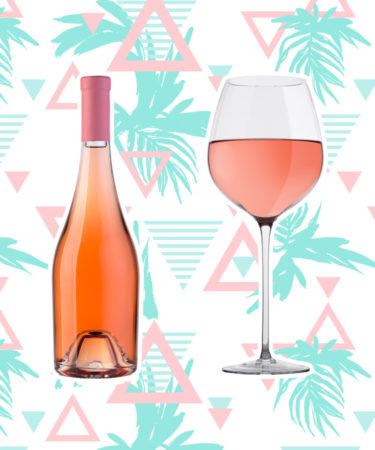Rosé is in full bloom. The category grew 53 percent by volume in 2017 and, given a recent flush of sales and product launches, 2018 is set to be another banner year.
If you have some lingering questions about rosé — where it comes from, how it’s made, and what makes it so popular — rest assured you’re not alone. Pink wines have existed for millennia, but their mainstream American success is pretty new. Here’s everything you want to know about rosé — but don’t want to be overheard asking.
Is rose a red or white wine?
Rosé is pink wine made from red wine grapes.
As with red wine, its color comes from contact with grape skins. To make both red and rosé wine, winemakers juice their grapes, and then let the liquid sit with the grape skins. This is called the maceration period. Pink wines sit with their skins for a relatively short time period, typically only one to three days
Related question: Can you make pink wine by mixing red and white wines together? Technically yes, but this practice is pretty frowned upon by most traditional winemakers.
Is all rosé French?
No, but you’d be forgiven for thinking so. In addition to that Gallic-accented “e,” France is home to the world’s most famous rosé region, Provence. People have been making pink wine in Provence since 600 BCE. Today a whopping 90 percent of the region’s wine production is pink. Provencal rosé exports to the United States reportedly increased tenfold between 2010 and 2016, with more than 1.3 million cases sent our way.
That said, rosé is not Provencal or French by definition. Oregon, Washington State, New York, South Africa, Australia, Chile, and many others make rosés. It’s called rosato in Italy, and rosado in Spain (and other Spanish-speaking parts of the world).
What food should you pair with rose?
Crisp and acidic, rosé is an extremely food-friendly category. Pair pink wines with oysters, roast chicken, asparagus, beet-and-goat-cheese salads, pad Thai, and anything you take off the grill. Rosé is also a great Thanksgiving wine, complementing turkey as well as fall flavors like roasted sweet potatoes and butternut squash.
Are darker-colored rosés sweeter than pale ones?
Nope. While many consumers associate darker rosés with the ultra-sweet and fruity blush wines that were popular in American in the 1980s (here’s looking at you, Sutter Home), there are a number of beautifully balanced rosés with richer, deeper hues. Tavel is “more ruby than pink,” Hai Tran, beverage director of Philadelphia’s Rittenhouse Hotel, told VinePair. Other excellent, ruby-toned options include Zoe Rosé and J.Vidal-Fleury Cotes du Rhone rosé, among others.
What’s the difference between rosé and White Zinfandel?
Funny story: Rosé and White Zin are made the exact same way. Both are produced using red wine grapes and a relatively short maceration period. White Zinfandel is just a sweeter version of rosé, which can be fruity but is characterized by dry, bracing acidity.
Is rosé expensive?
It’s certainly possible to spend a lot of money on rosé, in the same way that if you want to you can absolutely drop $25 on a hot dog. But rosé is historically not a pricey category. At one point in the U.S. you could reliably find great, easy-drinking French rosés for around $15, depending on local and international exchange. Demand has since grown enormously.
Given rosé’s popularity, and how inexpensive it is to make, some producers without the grapes, climate, or technique to do so are bottling alternatively cloying or chemical pink wines. The packaging on some of these bottles is lovely, and the price often less than $20, but satisfaction is not guaranteed. VinePair recently gathered a panel of experts and tasted hundreds of rosés for our annual ranking. We found that $20 to $30 was a sweet spot for category quality and value. You can absolutely still find great bottles for $10, and you can spend $50 and be really happy.
Just shop wisely. All that’s pink is not gold.
